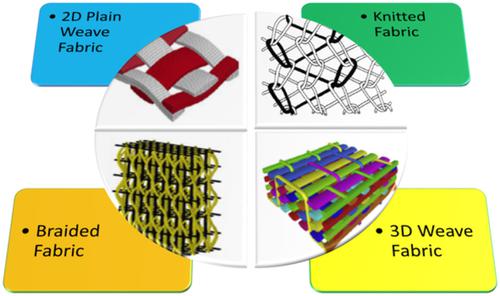当前位置:
X-MOL 学术
›
Polym. Compos.
›
论文详情
Our official English website, www.x-mol.net, welcomes your
feedback! (Note: you will need to create a separate account there.)
Effect of reinforcement architecture on the macroscopic mechanical properties of fiberous polymer composites: A review
Polymer Composites ( IF 4.8 ) Pub Date : 2020-06-05 , DOI: 10.1002/pc.25666 Furkan Ahmad 1 , N Yuvaraj 1 , Pramendra K. Bajpai 2
Polymer Composites ( IF 4.8 ) Pub Date : 2020-06-05 , DOI: 10.1002/pc.25666 Furkan Ahmad 1 , N Yuvaraj 1 , Pramendra K. Bajpai 2
Affiliation

|
In order to curb the fuel consumption and corresponding CO2 emission, defence, automobile, and aerospace industries are leaning towards the use of light weight‐high stiffness engineered materials like fiber reinforced polymer composites (FRPCs). One of the major advantages of FRPCs is that various properties (stiffness, tensile strength, flexural strength, etc.) can be tailored according to requirements of the application. Architecture of the reinforcement used in FRPCs has been proved to affect these properties substantially. Composite materials have seen a lot of advancement in the field of reinforcement architectures starting from the plain‐woven fabrics to advanced 3D braided/woven preforms. The architecture of reinforcement must be wisely selected to design the required properties of developed composites and to reduce the overall cost without compromising the performance. The problem addressed in the present study is the selection of reinforcement architecture while developing a composite material. 2D Plain woven reinforcements are better than other reinforcements in terms of in‐plane properties but their out‐of‐plane properties are very poor. Therefore, advanced architectures like 3D woven fabrics, 5D Braided preforms, knitted preforms, and 3D needle punched fibers are being used in various high performance applications. The present article is an attempt to analyse the effect of various available architectures of reinforcement on the macroscopic mechanical properties of FRPC laminates and to propose a systematic way to select a reinforcement.
中文翻译:

增强结构对纤维聚合物复合材料宏观力学性能的影响
为了抑制燃油消耗和相应的CO 2排放,国防,汽车和航空航天工业正倾向于使用轻质高刚度工程材料,例如纤维增强聚合物复合材料(FRPC)。FRPC的主要优点之一是可以根据应用需求定制各种特性(刚度,拉伸强度,弯曲强度等)。事实证明,FRPC中使用的钢筋结构会严重影响这些性能。从平纹织物到高级3D编织/机织预成型坯,复合材料在增强结构领域已取得了很大进步。必须明智地选择增强材料的结构,以设计已开发复合材料所需的性能,并在不影响性能的情况下降低总体成本。本研究解决的问题是在开发复合材料时如何选择增强结构。在平面内特性方面,二维平纹编织增强材料优于其他增强材料,但它们的平面外性能非常差。因此,诸如3D机织织物,5D编织预成型件,针织预成型件和3D针刺纤维之类的高级体系结构已用于各种高性能应用中。本文是试图分析各种可用的增强结构对FRPC层压板的宏观力学性能的影响,并提出一种选择增强材料的系统方法。在平面内特性方面,二维平纹编织增强材料优于其他增强材料,但它们的平面外性能非常差。因此,诸如3D机织织物,5D编织预成型件,针织预成型件和3D针刺纤维之类的高级体系结构已用于各种高性能应用中。本文是试图分析各种可用的增强结构对FRPC层压板的宏观力学性能的影响,并提出一种选择增强材料的系统方法。在平面内特性方面,二维平纹编织增强材料优于其他增强材料,但它们的平面外性能非常差。因此,诸如3D机织织物,5D编织预成型件,针织预成型件和3D针刺纤维之类的高级体系结构已用于各种高性能应用中。本文是试图分析各种可用的增强结构对FRPC层压板的宏观力学性能的影响,并提出一种选择增强材料的系统方法。
更新日期:2020-06-05
中文翻译:

增强结构对纤维聚合物复合材料宏观力学性能的影响
为了抑制燃油消耗和相应的CO 2排放,国防,汽车和航空航天工业正倾向于使用轻质高刚度工程材料,例如纤维增强聚合物复合材料(FRPC)。FRPC的主要优点之一是可以根据应用需求定制各种特性(刚度,拉伸强度,弯曲强度等)。事实证明,FRPC中使用的钢筋结构会严重影响这些性能。从平纹织物到高级3D编织/机织预成型坯,复合材料在增强结构领域已取得了很大进步。必须明智地选择增强材料的结构,以设计已开发复合材料所需的性能,并在不影响性能的情况下降低总体成本。本研究解决的问题是在开发复合材料时如何选择增强结构。在平面内特性方面,二维平纹编织增强材料优于其他增强材料,但它们的平面外性能非常差。因此,诸如3D机织织物,5D编织预成型件,针织预成型件和3D针刺纤维之类的高级体系结构已用于各种高性能应用中。本文是试图分析各种可用的增强结构对FRPC层压板的宏观力学性能的影响,并提出一种选择增强材料的系统方法。在平面内特性方面,二维平纹编织增强材料优于其他增强材料,但它们的平面外性能非常差。因此,诸如3D机织织物,5D编织预成型件,针织预成型件和3D针刺纤维之类的高级体系结构已用于各种高性能应用中。本文是试图分析各种可用的增强结构对FRPC层压板的宏观力学性能的影响,并提出一种选择增强材料的系统方法。在平面内特性方面,二维平纹编织增强材料优于其他增强材料,但它们的平面外性能非常差。因此,诸如3D机织织物,5D编织预成型件,针织预成型件和3D针刺纤维之类的高级体系结构已用于各种高性能应用中。本文是试图分析各种可用的增强结构对FRPC层压板的宏观力学性能的影响,并提出一种选择增强材料的系统方法。











































 京公网安备 11010802027423号
京公网安备 11010802027423号